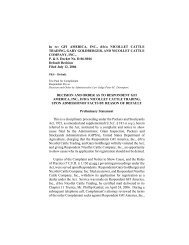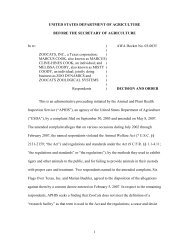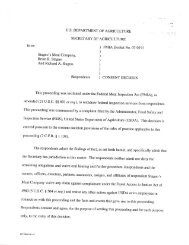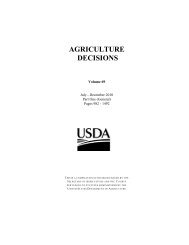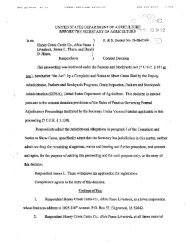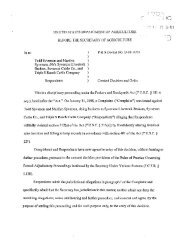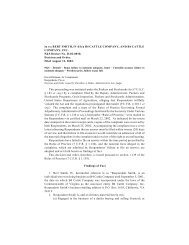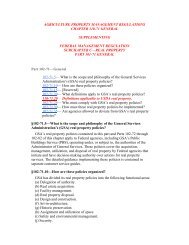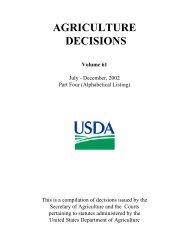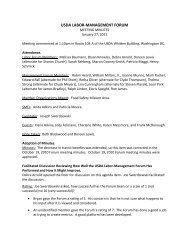Green Information Technology Strategic Plan - Departmental ...
Green Information Technology Strategic Plan - Departmental ...
Green Information Technology Strategic Plan - Departmental ...
Create successful ePaper yourself
Turn your PDF publications into a flip-book with our unique Google optimized e-Paper software.
Other Benefits<br />
The 4 EDCs chosen are designed to provide the correct<br />
operating environment for Federal Government systems.<br />
EDCs responsibility includes physical system security,<br />
operations management, cyber security, scan and patch of<br />
operating systems, and continuity of operations. In addition,<br />
USDA will be moving the planning and development of<br />
hardware architecture for systems to the OCIO, under<br />
the executive responsible for the Enterprise Data Centers.<br />
In a study conducted by OCIO, the hardware architecture<br />
for approximately 250 network application servers was<br />
reviewed. For these servers, better hardware architecture<br />
would improve system performance and result in a savings of<br />
approximately $10 million (payroll, hardware, application,<br />
and energy expense).<br />
—Increased Security<br />
70<br />
The Midwest EDC received a Tier 3 Telecommunications Industry Association Standards<br />
for Data Centers rating, which translates to a 99.741% availability rate.<br />
Data center security is an immense threat due to the USDA<br />
data centers having various security policies and requirements.<br />
Without a central body working toward consolidation, there<br />
is no oversight which guarantees that all data centers are fully<br />
secure from all threats. Data centers house privacy, sensitive,<br />
and personal identifiable information. The USDA can illafford<br />
to have security falter on any front. Consolidation<br />
will increase security due to all EDCs operating under a<br />
unified security policy. These efforts ensure that all missioncritical<br />
systems will be protected on an ongoing basis.<br />
—Limit the Impact of Rising Energy Prices<br />
Consolidation will limit the impact of rising energy prices on<br />
operational budgets. Most large enterprise IT organizations<br />
spend approximately 5% of their total IT budgets on energy.<br />
Gartner research suggests that this number will rise by two to<br />
three times within 5 years. Not only because of the increasing<br />
energy consumption of data centers, but also because of the<br />
steady rise of KWh charges. With less hardware, there will<br />
be less energy needed to power equipment and less energy<br />
consumed for cooling the data center. This not only helps<br />
to curb the USDA appetite for power, but also protects the<br />
organization from rising commodity prices. Moving data<br />
center and net closet equipment to areas that charge less for<br />
electricity also protects USDA from the rise in energy prices.<br />
The incremental increases in utility costs are even more<br />
protected from approaching the National average.<br />
—Ease of Maintenance<br />
Once data centers have the virtualization technology in<br />
place, the ease of maintenance for replacing servers becomes<br />
evident. If a server in the server pool goes down, all that<br />
is needed is for a technician to pull the bad server out and<br />
replace it with a new one. Since the new server is hooked in<br />
to a pool, it will then receive its tasks from the data manager<br />
for processing jobs and begin working. There is no longer a<br />
need for configuration and coding.<br />
—Less Application Downtime<br />
Data center consolidation to EDCs will provide for less<br />
application downtime in two ways: 1.) The EDC locations<br />
have a higher availability rate than the decentralized Agency<br />
data centers, as determined by the Telecommunications<br />
Industry Association (TIA) Standards for Data Centers<br />
(TIA-942), and 2.) Virtualization enables less application<br />
downtime by directing workload to other servers.<br />
The Midwest EDC received a Tier 3 TIA-942 rating<br />
which translates to a 99.741% availability rate. EDCs are<br />
designed and constructed to meet these types of stringent<br />
requirements that other data centers are unable to meet.<br />
By simply moving all applications into EDCs, application<br />
availability USDA-wide makes an immediate jump up.<br />
Virtualization software further decreases application<br />
downtime by directing workload to a pool of available<br />
servers. If a server goes down, the software will send all<br />
processing instructions to the other servers in the pool, thus<br />
reducing any down-time for mission-critical applications.<br />
<strong>Green</strong> <strong>Information</strong> <strong>Technology</strong> <strong>Strategic</strong> <strong>Plan</strong>




